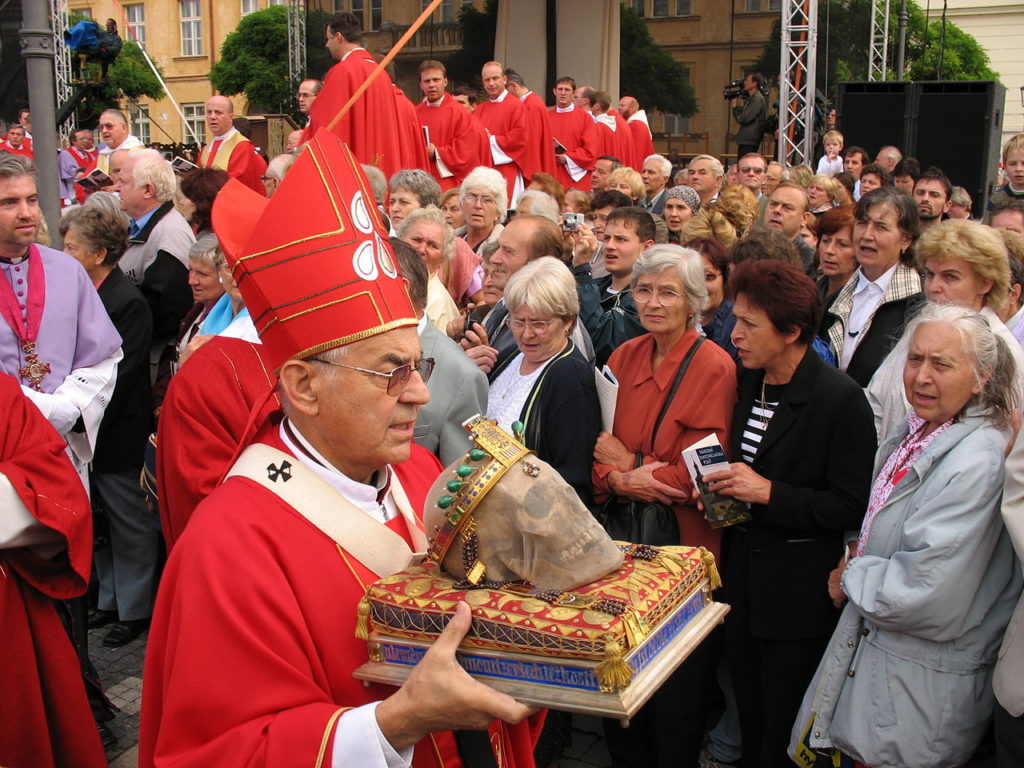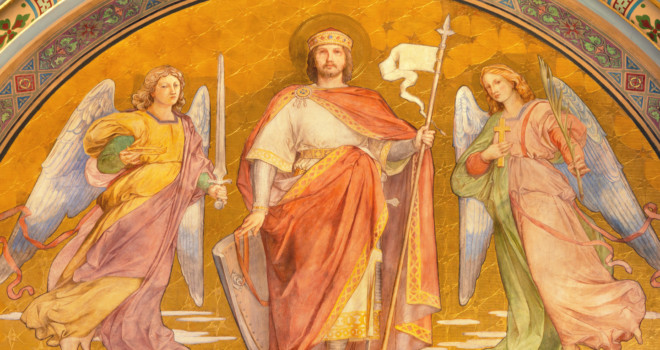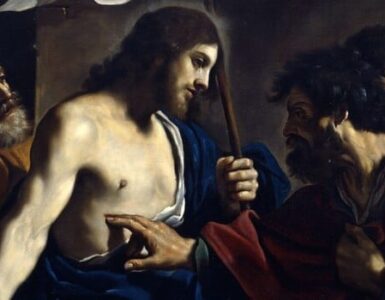There’s a strong chance that if you are familiar with today’s saint, St. Wenceslas, it’s in the context of the timeless Christmas carol, Good King Wenceslas. This song is so ubiquitous that you are probably humming it right now. In fact, few children will get through their first Christmas without singing it, either in Church or at home, but very few of them will learn more about this amazing saint.
The memorable song recounts a charitable king who takes food, fuel, and wine to a poor man on the feast of St. Stephen. While he was oftentimes called the Good, there are a couple of small errors in this song. For one, St. Wenceslas (Svatý Václav in his native Czech) was reigning at a time when the rulers of Prague were called by the Slavic title kníže, which is often rendered as duke (but he would be called king later). As well, the story recounted in the Christmas tune is not necessarily one we find in Hagiography, but we do indeed have tales of Wenceslas giving alms and releasing prisoners on major feast days. But perhaps Kníže St. Václav the Good doesn’t have the same ring
Whatever the facts are, many of us learned the name St. Wenceslas through this song but he is a man worth knowing. St. Wenceslas is a figure whose memory went from beyond the borders of his small kingdom to influence countless souls. If you ask around Prague, they say he will even come back again (more on that later). So, to celebrate his feast, here are a few things to know about St. Wenceslas.
1. Noble and Saintly Family
St. Wenceslas was born to nobility, namely in that he had royal blood. He was born to the House of Přemyslid, whose rule traced back to the mythical foundations of Prague. Like many royal families, the Přemyslids had a few cruel characters. However, Wenceslas is bound to a greater nobility: the communion of saints.
Wenceslas’s grandparents, Bořivoj and St. Ludmila, were the first Czech rulers to receive baptism after the successful mission of Sts. Cyril and Methodius to the Slavs. In fact, some sources indicate that Ludmila was baptized by St. Methodius himself. Whoever baptized her, Ludmila took the mission of Christ quite seriously. This was a dangerous task as so many members of her family and nation still practiced paganism.
St. Ludmila saw to it that St. Wenceslas was educated as a Christian, despite the objections of his mother. Through her tireless efforts, St. Wenceslas grew to become a good, Christian king who ruled with prudence but was also willing to dispense mercy.
Wenceslas would provide the example for many people who answer the call to sainthood. Within his own family, we already touched on the example of St. Ludmila, but he is related to several other saints, which include St. Agnes of Bohemia and St. Elizabeth of Hungary.
2. A Family of Martyrs
St. Ludmila was a grandma and spiritual mother to St. Wenceslas. The Christian example of Ludmila, however, did not please all of her family and court. When she first converted, she and Duke Bořivoj had to flee from their throne and nation due to a pagan backlash. Years later, after Wenceslas had been declared the new ruler, Ludmila would attract the scorn of her own daughter in law.
Drahomíra, Wenceslas’s mother, was born a pagan but accepted baptism before her wedding. However, it doesn’t seem that she had the sincere conversion of her mother-in-law. St. Ludmila had a great influence on Wenceslas and Drahomíra was jealous of this and also desired to bring back the pagan customs of old. To that end, Drahomíra ordered two assassins to kill St. Ludmila, which they did by strangling her with her chapel veil.
Like his grandmother, St. Wenceslas desired the conversion of his people. As the ruler, he built many churches and chapels, including the basilica where he buried his grandmother. Wenceslas would also free prisoners, especially during Christmas, as an act of mercy for his subjects. And like his grandmother, his character and witness attracted the attention of murderous relatives.
Boleslaus the Cruel, Wenceslas’s brother, set out to kill the future saint, who was celebrating the feast of Sts. Cosmas and Damian. As St. Wenceslas gripped the door of the chapel, he was attacked by three assassins who stabbed him. Some accounts say that it was Boleslaus himself who delivered the final blow to Wenceslas as the saintly prince exclaimed, “Brother, what are you trying to do!”
3. A National Martyr
St. Wenceslas was recognized as a martyr soon after his death. Boleslaus would eventually repent of his wickedness and the relics of St. Wenceslaus would eventually find their way back to Prague Castle, not far from where St. Ludmila was buried.
If you were able to attend the divine liturgy at Prague Castle on the feast of St. Wenceslas, within the gothic walls of St. Vitus Cathedral, you would be treated to a Mass that is worthy of such a saint. For one, you would hear what might be the oldest Czech hymn, Svatováclavský chorál (Saint Wenceslas Chorale) which goes back to at least the 13th century. However, the central object of this day is the skull of St. Wenceslas, still wearing the crown of his nation.

In the Czech Republic, St. Wenceslas is a saint and national hero, a holy founder who still inspires the people who walk around his magnificent city of Prague. In fact, many of the events of Velvet Revolution in 1989 happened right beneath the equestrian statue of St. Wenceslas in the city’s largest square, which also bears his name.
And not far from Prague is the mountain of Blaník. According to legend, a group of soldiers sleeps there in waiting for when the Czech people most need them. And who should rise to lead them in these tumultuous days but St. Wenceslas himself, who will never forget to watch over his people and all peoples who ask for his intercession.
If you ever get to Prague, visit his chapel, read the plaques on Wenceslas Square, and admire the legacy of this overlooked saint. And, if possible, light a candle and pray before his relics.
St. Wenceslas, Pray for Us.
✠
image: The fresco of king Saint Wenceslaus in church Svatého Cyrila Metodeje by František Sequens via Renata Sedmakova / Shutterstock.com













